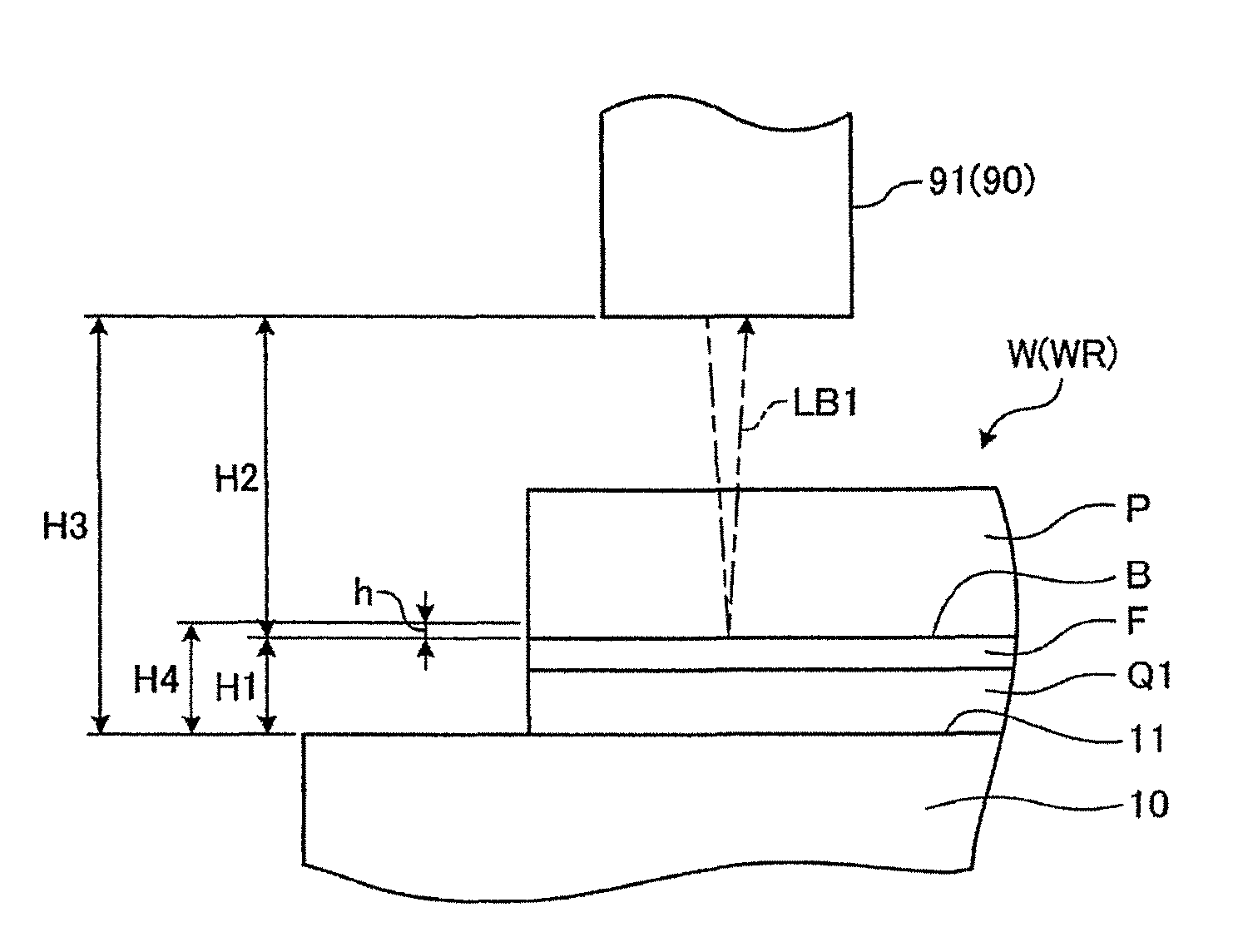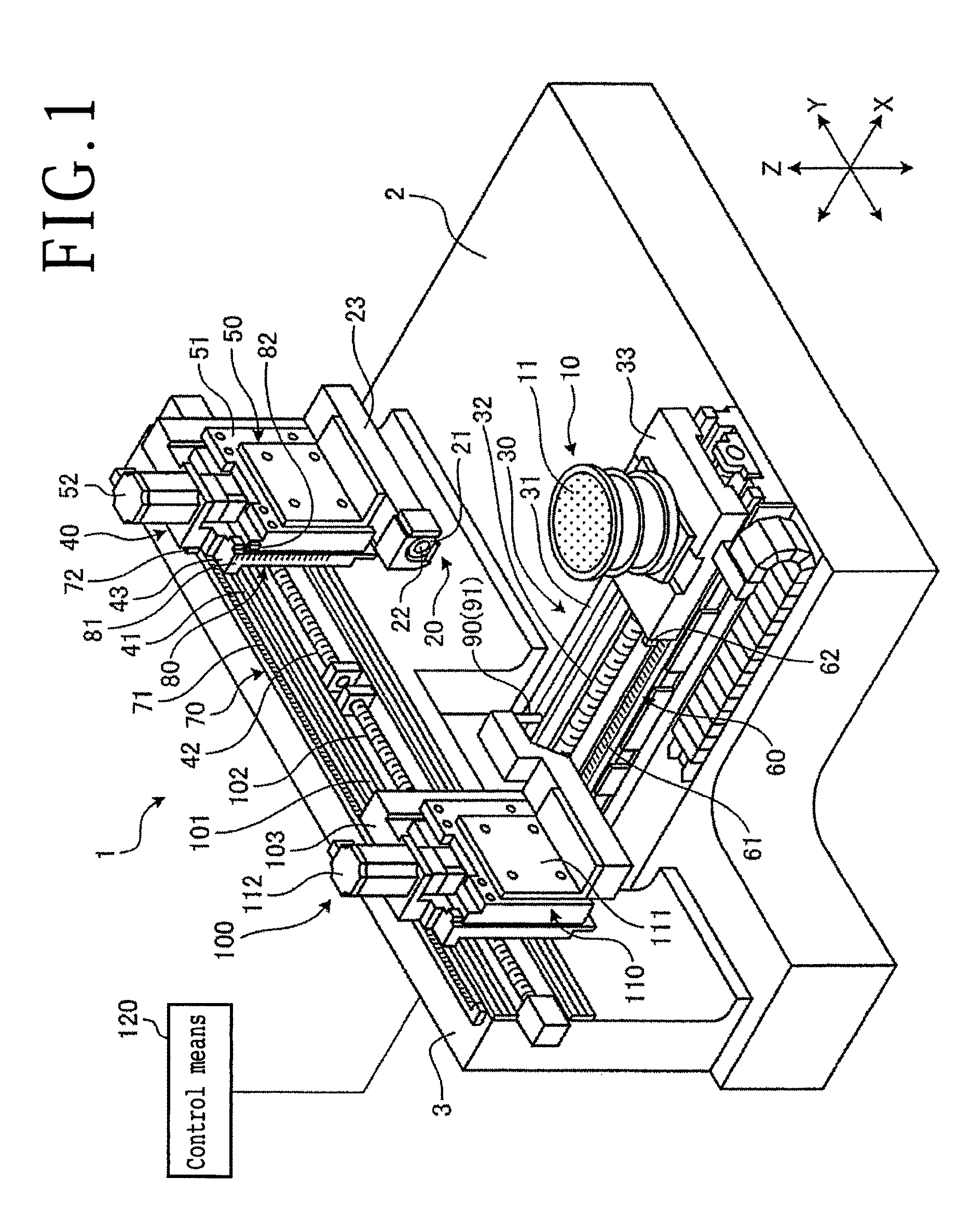Wafer processing method
a processing method and wafer technology, applied in semiconductor/solid-state device testing/measurement, semiconductor device details, semiconductor devices, etc., can solve the problems of inability to accurately divide wafers, the cutting blade may be deviated or tilted, and the functional layer cannot be uniformly cut by the cutting blade. , to achieve the effect of accurately splitting the wafer
- Summary
- Abstract
- Description
- Claims
- Application Information
AI Technical Summary
Benefits of technology
Problems solved by technology
Method used
Image
Examples
first preferred embodiment
[0029]A first preferred embodiment of the wafer processing method according to the present invention will now be described. FIG. 1 is a perspective view showing the configuration of a cutting apparatus 1 for performing the first preferred embodiment. FIG. 2 is a perspective view showing the configuration of a wafer W to be processed by the cutting apparatus 1. FIG. 3 is a sectional view of the wafer W shown in FIG. 2. The cutting apparatus 1 is designed to cut the wafer W. As shown in FIG. 1, the cutting apparatus 1 includes a chuck table 10, cutting means 20, work feeding means (X moving means) 30, indexing means (first Y moving means) 40, cutter feeding means (first Z moving means) 50, X position detecting means 60, Y position detecting means 70, and Z position detecting means 80.
[0030]The wafer W includes various kinds of wafers such as a semiconductor wafer and an optical device wafer. The semiconductor wafer is composed of a substrate formed of silicon, gallium arsenide, etc. a...
second preferred embodiment
[0055]A second preferred embodiment of the wafer processing method according to the present invention will now be described. FIGS. 19 and 20 are sectional views showing a dividing step of dividing the wafer W by plasma etching according to the second preferred embodiment.
[0056]After forming the cut groove Pd on the back side WR of the wafer W along each division line L of the wafer W, a resist film R1 is formed on the back side WR of the wafer W in the area except each remaining part Pa as shown in FIG. 19. More specifically, the material of the resist film R1 is first applied to the whole of the back side WR of the wafer W, and next exposed to light through a predetermined mask pattern. Thereafter, the wafer W is immersed in a developer to thereby remove the resist film R1 from each remaining part Pa. Thus, the resist film R1 is formed on the back side WR of the wafer W in the area except each remaining part Pa. After forming the resist film R1 as mentioned above, the wafer W is su...
third preferred embodiment
[0057]A third preferred embodiment of the wafer processing method according to the present invention will now be described. FIGS. 21 and 22 are sectional views showing a dividing step of dividing the wafer W by using a cutting blade according to the third preferred embodiment.
[0058]After forming the cut groove Pd on the back side WR of the wafer W along each division line L of the wafer W, a cutting blade 21A having a thickness smaller than that of the cutting blade 21 is used to cut the remaining part Pa and the functional layer F along each division line from the back side WR of the wafer W, thereby forming a division groove Pf along each division line L as shown in FIGS. 21 and 22. In this manner, the remaining part Pa and the functional layer F along each division line L may be cut by using the cutting blade 21A rather than by using the laser processing apparatus 200 in the dividing step.
PUM
 Login to View More
Login to View More Abstract
Description
Claims
Application Information
 Login to View More
Login to View More - R&D
- Intellectual Property
- Life Sciences
- Materials
- Tech Scout
- Unparalleled Data Quality
- Higher Quality Content
- 60% Fewer Hallucinations
Browse by: Latest US Patents, China's latest patents, Technical Efficacy Thesaurus, Application Domain, Technology Topic, Popular Technical Reports.
© 2025 PatSnap. All rights reserved.Legal|Privacy policy|Modern Slavery Act Transparency Statement|Sitemap|About US| Contact US: help@patsnap.com



